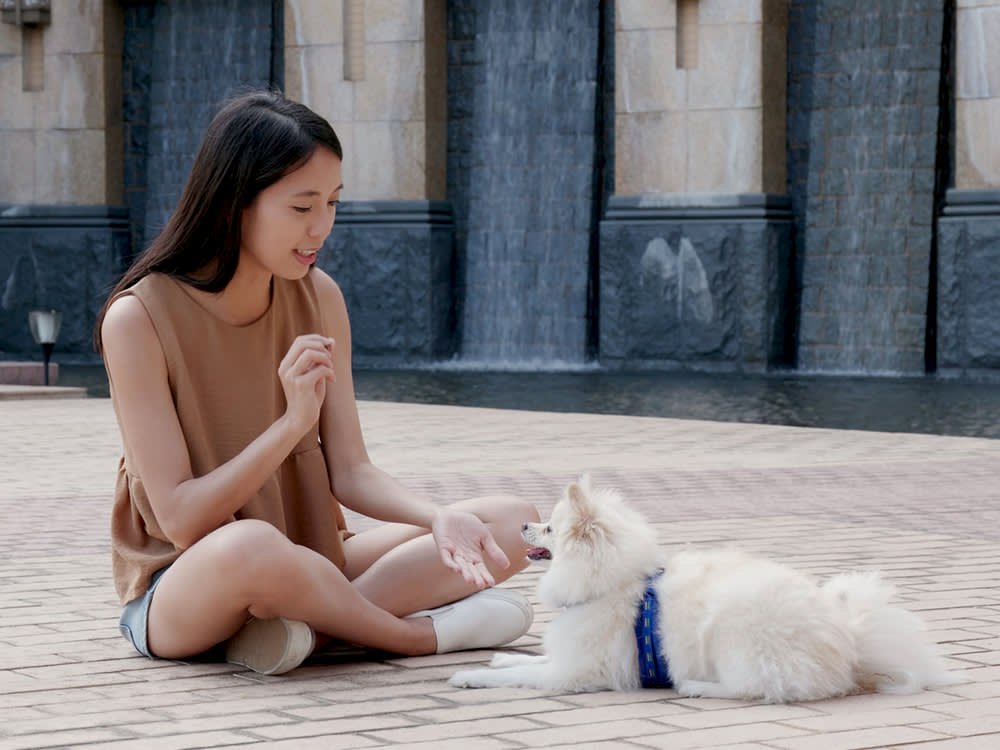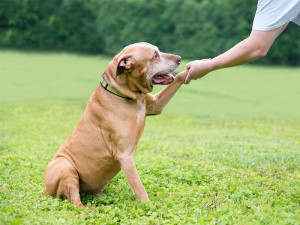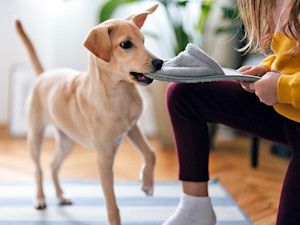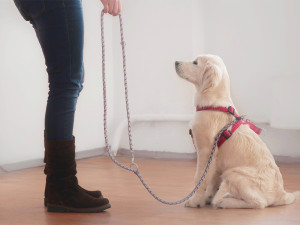Expert-Backed Step-By-Step Guide to Training Your Dog to Sit
In dog training, taking things one step at a time can make a world of difference.

Share Article
In This Article:
Methods to Help Train Your Dog to Sit Supplies You’ll Need Before Training How to Train Your Dog to Sit Things to Avoid When Training Your Dog to Sit Frequently Asked Questions
While it seems like your dog could spend all day chasing Frisbees and rolling in nasty stuff, they do have to sit at some point. Because the journey from adoring pet parent to Tenured Professor of Sitting takes some practice, we asked professional dog trainers for their expert advice on teaching this most fundamental skill.
Methods to help train your dog to sit
One of the most reliable techniques to train your dog to sit (or stay, or go to their mat, or even execute a fancy flip-finish trick) is the lure method. According to Erin Whelanopens in new tab, founder of Little Wolf Dog Trainingopens in new tab, the lure method involves placing a small piece of food in your hand and moving it in such a way as to lure your dog to perform the desired behavior. In this case, sitting. Who doesn’t love some positive reinforcement? And snacks?
Another method uses a box clicker, a small noisemaker that makes a short, percussive click sound that sends a definite cue to your dog. Trainer Robert Haussmann of Dogboy NYC, says, “The clicker is used to connect the desired behavior to the reward. Timing is important, and the clicker can be used to immediately mark when the dog completes the behavior and clarify why they are being rewarded.”
How much do you spend on your pet per year?

Supplies you’ll need before training
As for supplies, Haussmann says you can buy a clicker if you want to, (though you can also just use your voice) he also recommends that his clients purchase a pouch for holding treats, especially one that can go into the dishwasheropens in new tab.
Then, of course, you’ll need the goodies themselves. Haussmann says, “Treats should be small so your dog can have multiple in a training session. They should vary in value, so the dog never knows what they’re gonna get and is eager to stay engaged. You should definitely have some very high value treats that are rare and special to your dog.”
How to train your dog to sit
Now that you are stocked up, you and your dog are ready to get to work. Whelan recommends the following steps:
Hold a treat in your hand. She says, “I recommend placing the treat in-between your fingertips, so your hand makes a sort of tear drop shape.”
Move the treat above your dog’s head.
Hold your fingertips against your dog’s nose so they are aware of the treat. They should be able to smell the treat but not eat it out of your hand.
While maintaining light contact with your dog’s nose, slowly move your hand up and over your dog’s head so they follow your hand with their eyes and head.
When their butt hits the ground, mark the behavior by saying “Yes!” or using a clicker and open your hand to feed your dog the treat.
Repeat five times or until you are able to fluidly lure your dog into a reliable sit. At this point, you’re ready to back off the treats.
Keeping the same hand shape you established while luring your dog, repeat the above steps with an empty hand.
Things to avoid when training your dog to sit
“Do not force your dog into a sit by pushing on their body,” Haussmann warns.
Also, try to avoid their behavior becoming contingent on the presence of treats. “Once the behavior is predictable you want to become a slot machine — not a vending machine,” he says. “Occasionally reward with verbal praise, other times with multiple treats (jackpot). You want to keep it interesting and turn your dog into a compulsive gambler.”
FAQs
How long does it take to teach a dog to sit?
“This completely depends on the dog, the environment in which they're working, the level of distractions present, and the value of the reinforcer involved,” Whelan says. “I’ve seen dogs learn how to sit on cue fairly reliably in just a few minutes, and I once had a Frenchie in one of my group classes who finally got there after five to six weeks of both me AND his guardians working with him.”
Is there a maximum number of repetitions per session to avoid overwhelming the dog?
Whelan’s advice: “I always recommend working with your dog for up to one minute at a time when you’re just starting your training journey. Some dogs are born with incredible stamina, and for others it can take time to build the drive to work for longer periods of time. Set a timer for one minute, do a bit of work, then give them a quick break. You can play with them for a few minutes — if they enjoy that, toss a few treats into a snuffle mat. When they're done, do another minute. I always encourage my clients to keep their training sessions short, especially to start, and to stop while their dog is still enjoying themselves.”
How important is tone of voice when giving the “sit” command?
Haussmann says, “I recommend training any cue in a variety of voice tones, otherwise you'll have to say it the same way every time you give your dog the cue.”
What do you do if your dog just refuses to sit?
“It usually means you are in an environment that is too distracting, or you are working with an overly tired puppy. Change what you are doing or seek professional help,” Haussmann says.
He warns against frustration about what may seem like anti-social acting out by your dog during training saying, “People tend to feel the need to raise their voice or become stern when a dog is less compliant or able to listen. The dog’s compliance is usually dependent on the environment and external distraction. It is important to recognize what your dog is capable of before putting them in a situation that may be un-winnable for you and your dog. If you put your dog up above their grade level, then shout and get agitated until they comply, training becomes less fun for both you and your dog.”
Any advanced tips for reinforcing the “sit” request over time?
“Practice makes progress,” Hausmann says. “Just because your dog will do it doesn’t mean that they know it in all circumstances and situations. Training should be fun for you and for your dog. Think of it as a game you play together. If you’re patient and consistent, you should be able to have your dog sit in most situations and environments.”

T. Kent Jones
T. Kent Jones is a writer and broadcaster whose work has been featured on The Daily Show on Comedy Central, The Rachel Maddow Show on MSNBC, Morning Sedition with Marc Maron on Air America Radio and in many publications and comedy websites. He lives in New York City with his wife, Kelly, and their rescue Schnoodle, Pops, who suffers much foolishness with stoic forebearance.
Related articles
![illustration of multi-colored dogs]()
Is Your Dog Tricky to Train? Here’s Why You Shouldn’t Feel Guilty
It’s important to remember that dogs are individuals, so training isn’t one-size-fits-all.
![Puppy stealing slipper from woman at home.]()
How to Teach a Dog to “Drop It”
The most important cue your dog doesn’t know. Yet.
![Tan Chihuahua dog laying on aqua rug looking down shamefully]()
“Why Is My Adult Dog Peeing In The House?”
How to re-housetrain a dog of any age.
![a dog held on a leash sits calmly]()
Dogs Who Are Easy to Train: Top 10 Easiest Dogs to Train
Spoiler: It’s not about the breed. But these pups are pretty brainy.






